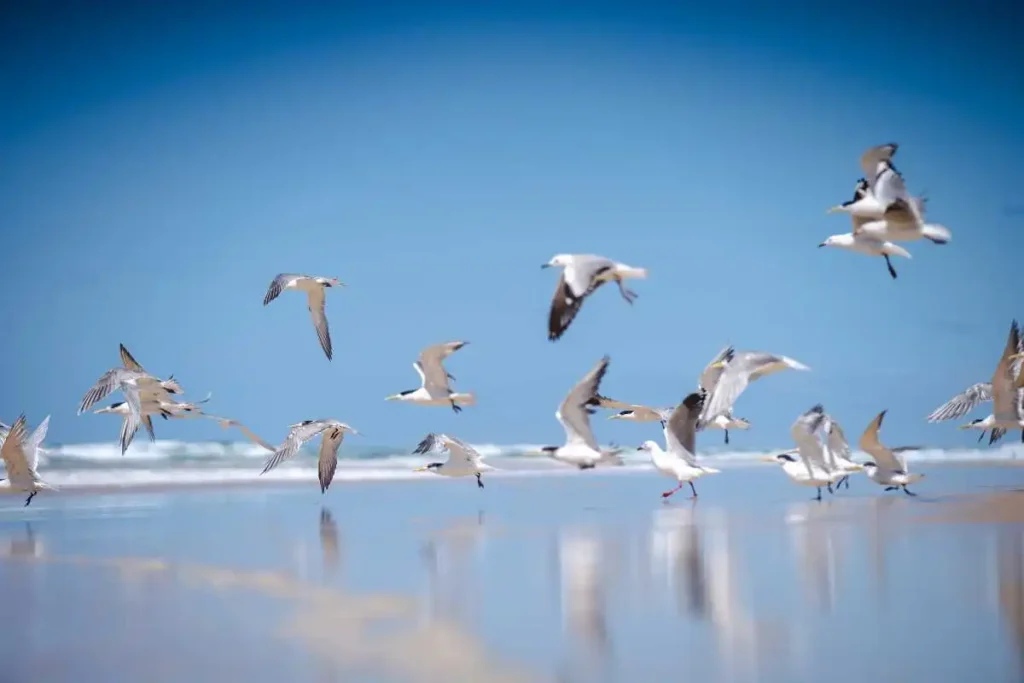Gulls are a common sight along coastlines, often seen soaring over the ocean or scavenging along the shore. These seabirds have captivated the attention of bird enthusiasts, scientists, and nature lovers alike. But what makes a gull a seabird, and how are gulls related to other seabirds? This article explores these fascinating birds, the different types of gulls, and their behaviors, including whether seagulls migrate. We will also delve into specific species like the grey gull and herring gull (Larus argentatus), providing a comprehensive look at these fascinating creatures.
Table of Contents

1. What Defines a Seabird?
Seabirds are a group of birds that primarily live near or on the ocean. They are specially adapted to their environment, with features that help them navigate, hunt, and thrive in marine ecosystems. Unlike other birds, seabirds typically spend a significant amount of their life at sea, coming to land only to breed. Gulls are a well-known example of seabirds. With their versatile feeding habits and ability to adapt to various environments, they bridge the gap between the sea and land, making them a unique group among seabirds.
2. Gulls: The Versatile Seabirds
Gulls are part of the family Laridae and are commonly referred to as seagulls. However, not all gulls strictly adhere to the sea; some are found inland near lakes and rivers. Gulls are characterized by their robust bodies, long wings, and distinctive calls. They are highly adaptable birds, capable of thriving in different habitats and climates. From urban areas to remote beaches, gulls have shown a remarkable ability to coexist with human development, making them one of the most recognized seabird groups worldwide.
3. Types of Gulls and Their Habitats
There are over 50 species of gulls worldwide, each with its unique characteristics and habitat preferences. Some of the most well-known types of gulls include:
- Grey Gull (Larus modestus): This species is found along the coasts of South America, particularly in Chile and Peru. Grey gulls are known for their grey plumage and are unique among gulls due to their nesting habits. Unlike other gulls that nest on the ground near water, grey gulls migrate to inland deserts to nest, sometimes traveling hundreds of kilometers away from the ocean.
- Herring Gull (Larus argentatus): One of the most familiar gulls in North America and Europe, the herring gull has a white body with grey wings and a yellow beak. It is commonly found along coastlines, harbors, and urban areas where it feeds on fish, invertebrates, and even human food scraps. The herring gull is often associated with coastal environments but is equally at home in inland habitats.
- Sea Gull: A generic term often used to describe any gull species found near the sea. In reality, many types of gulls are referred to as sea gulls, although this name doesn’t correspond to a specific species.
- Argentatus Herring Gull: This is a subspecies of the herring gull, often seen in Europe. It is slightly larger and lighter in color compared to other herring gulls. The argentatus herring gull is commonly found in the Baltic Sea region and is known for its distinct calls and feeding behavior.
4. Do Seagulls Migrate?
Migration is a common behavior among many bird species, including gulls. The herring gull migrates from its breeding areas in the Arctic to warmer coastal regions during winter. However, not all gulls migrate. Some species, like those in urban environments, remain in the same area year-round, benefiting from human-provided food sources. The grey gull, as mentioned earlier, migrates inland for breeding, showcasing the diverse migratory patterns found among gulls.

5. The Role of Gulls in the Ecosystem
Gulls play a crucial role in their ecosystems. As scavengers, they help clean up the environment by feeding on dead fish, waste, and other organic matter. This feeding behavior helps control populations of other species and contributes to the overall health of their habitats. Gulls are also important indicators of environmental health. Changes in gull populations can signal shifts in the availability of food sources, pollution levels, and the effects of climate change.
6. Conservation of Gulls and Other Seabirds
While some gull species are thriving, others face challenges due to habitat loss, pollution, and overfishing. Conservation efforts are crucial to protect these seabirds and their habitats. By understanding the behaviors and needs of gulls, conservationists can develop strategies to preserve important breeding and feeding grounds. Protecting coastal areas, reducing plastic pollution, and monitoring fish stocks are some ways to ensure that gulls and other seabirds continue to thrive.
Gulls are fascinating seabirds that play a significant role in marine and coastal ecosystems. From the grey gull’s inland nesting to the herring gull’s adaptability to urban environments, gulls showcase a variety of behaviors and adaptations that make them unique. By understanding the different types of gulls and their relationship to other seabirds, we can appreciate the diversity of life that thrives along our shorelines and seas. Whether you spot a sea gull near the ocean or a herring gull in a city park, these birds remind us of the intricate connections between the natural world and our everyday lives.

